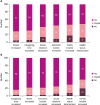1. Yang YS, Yang HD, Hong YJ, Kim JE, Park MH, Na HR, et al. Activities of daily living and dementia. Dement Neurocogn Disord. 2012; 11:29–37.

2. Mahoney FI, Barthel DW. Functional evaluation: the barthel index. Md State Med J. 1965; 14:61–65.
3. Lawton MP, Brody EM. Assessment of older people: self-maintaining and instrumental activities of daily living. Gerontologist. 1969; 9:179–186.


6. Gustavsson A, Brinck P, Bergvall N, Kolasa K, Wimo A, Winblad B, et al. Predictors of costs of care in Alzheimer's disease: a multinational sample of 1222 patients. Alzheimers Dement. 2011; 7:318–327.


7. Kim MD, Hong SC, Lee CI, Kim SY, Kang IO, Lee SY. Caregiver burden among caregivers of Koreans with dementia. Gerontology. 2009; 55:106–113.


8. Vossius C, Selbæk G, Šaltytė Benth J, Bergh S. Mortality in nursing home residents: a longitudinal study over three years. PLoS One. 2018; 13:e0203480.

9. Bremer P, Cabrera E, Leino-Kilpi H, Lethin C, Saks K, Sutcliffe C, et al. Informal dementia care: consequences for caregivers' health and health care use in 8 European countries. Health Policy. 2015; 119:1459–1471.


10. Choi HJ, Yang YS, Kim HJ, Na HR, Shim YS, Park KW, et al. The survey for current state and dognition of activities of daily living in dementia patients- “Il-sang-ye-chan” campaign. Dement Neurocogn Disord. 2013; 12:47–51.

11. Suh GH. Development of the Korean version of disability assessment for dementia scale(DAD-K) to assess function in dementia. J Korean Geriatr Soc. 2003; 7:278–287.
12. Kang SJ, Choi SH, Lee BH, Kwon JC, Na DL, Han SH, et al. The reliability and validity of the Korean instrumental activities of daily living (K-IADL). J Korean Neurol Assoc. 2002; 20:8–14.
13. Ku HM, Kim JH, Kwon EJ, Kim SH, Lee HS, Ko HJ, et al. A study on the reliability and validity of Seoul-instrumental activities of daily living(S-IADL). J Korean Neuropsychiatr Assoc. 2004; 43:189–199.
14. Gold DA. An examination of instrumental activities of daily living assessment in older adults and mild cognitive impairment. J Clin Exp Neuropsychol. 2012; 34:11–34.


15. Norton MC, Smith KR, Østbye T, Tschanz JT, Corcoran C, Schwartz S, et al. Greater risk of dementia when spouse has dementia? The Cache County study. J Am Geriatr Soc. 2010; 58:895–900.

17. Ngandu T, Lehtisalo J, Solomon A, Levälahti E, Ahtiluoto S, Antikainen R, et al. A 2 year multidomain intervention of diet, exercise, cognitive training, and vascular risk monitoring versus control to prevent cognitive decline in at-risk elderly people (FINGER): a randomised controlled trial. Lancet. 2015; 385:2255–2263.


18. Choi HJ, Moon YS, Lee CN, Yang YS, Song EH, Kim HJ, et al. The survey for the effect of guideline about activities of daily living in dementia patients “Il-sang-ye-chan” campaign. Dement Neurocogn Disord. 2014; 13:101–106.









 PDF
PDF ePub
ePub Citation
Citation Print
Print





 XML Download
XML Download